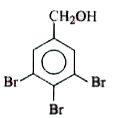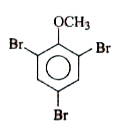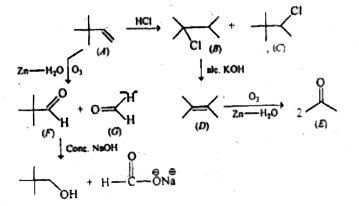CrO3 dissolved in aqueous NaOH to give:
CrO2−4
Cr(OH)3
Cr2O2−7 ions is reduced to Cr
Cr(OH)2
The correct Answer is:A
To solve the question of what product is formed when CrO₃ is dissolved in aqueous NaOH, we can follow these steps:
Step 1: Write the Reactants
We start with the reactants given in the question:
- Chromium trioxide (CrO₃)
- Sodium hydroxide (NaOH)
Step 2: Write the Chemical Reaction
When CrO₃ reacts with NaOH, the reaction can be represented as:
CrO3+NaOH→Na2CrO4+H2O
Step 3: Balance the Reaction
To balance the reaction, we need to ensure that the number of atoms of each element is the same on both sides of the equation. In this case, we need to add coefficients to balance the sodium (Na) and hydroxide (OH) ions:
CrO3+2NaOH→Na2CrO4+H2O
Step 4: Identify the Products
From the balanced equation, we can see that the products of the reaction are:
- Sodium chromate (Na2CrO4)
- Water (H2O)
Step 5: Write the Ionic Form of the Product
The sodium chromate can be expressed in ionic form as:
2Na++CrO2−4
Step 6: Conclusion
Thus, when CrO₃ is dissolved in aqueous NaOH, the main product formed is the chromate ion (CrO2−4) along with sodium ions (Na+).
Final Answer
The correct answer to the question is that CrO₃ dissolved in aqueous NaOH gives CrO2−4 ions.
---
We start with the reactants given in the question:
- Chromium trioxide (CrO₃)
- Sodium hydroxide (NaOH)
When CrO₃ reacts with NaOH, the reaction can be represented as:
CrO3+NaOH→Na2CrO4+H2O
To balance the reaction, we need to ensure that the number of atoms of each element is the same on both sides of the equation. In this case, we need to add coefficients to balance the sodium (Na) and hydroxide (OH) ions:
CrO3+2NaOH→Na2CrO4+H2O
From the balanced equation, we can see that the products of the reaction are:
- Sodium chromate (Na2CrO4)
- Water (H2O)
The sodium chromate can be expressed in ionic form as:
2Na++CrO2−4
Thus, when CrO₃ is dissolved in aqueous NaOH, the main product formed is the chromate ion (CrO2−4) along with sodium ions (Na+).
The correct answer to the question is that CrO₃ dissolved in aqueous NaOH gives CrO2−4 ions.
Topper's Solved these Questions
- D BLOCK ELEMENTSBOOK - RESONANCE ENGLISHCHAPTER - D BLOCK ELEMENTSEXERCISE - EXERCISE-I PART-III
15 Videos
- D BLOCK ELEMENTSBOOK - RESONANCE ENGLISHCHAPTER - D BLOCK ELEMENTSEXERCISE - EXERCISE-2 PART-I
27 Videos
- D BLOCK ELEMENTSBOOK - RESONANCE ENGLISHCHAPTER - D BLOCK ELEMENTSEXERCISE - EXERCISE-I PART-I
40 Videos
- D & F BLOCK ELEMENTSBOOK - RESONANCE ENGLISHCHAPTER - D & F BLOCK ELEMENTSEXERCISE - ORGANIC CHEMISTRY(Aldehydes , Ketones, Carboxylic acid)
15 Videos
- DPPBOOK - RESONANCE ENGLISHCHAPTER - DPPEXERCISE - QUESTIONS
368 Videos
Similar Questions
Knowledge Check
Compound (A) C7H8O is insoluble in aqueous NaHCO3 and dissolves in aqueous NaOH and gives a characteristic colour with neutral FeCl3 . When treated with Br2 (A) forms compound (B) C7H5OBr3 .
The structure of compound (B) would be :A B
B C
C D
D
Compound (A) C7H8O is insoluble in aqueous NaHCO3 and dissolves in aqueous NaOH and gives a characteristic colour with neutral FeCl3 . When treated with Br2 (A) forms compound (B) C7H5OBr3 .
The most probable structure of compound A is :A B
B C
C D
D
Compound (A) C7H8O is insoluble in aqueous NaHCO3 and dissolves in aqueous NaOH and gives a characteristic colour with neutral FeCl3 . When treated with Br2 (A) forms compound (B) C7H5OBr3 .
The most probable structure of compound A is :A B
B C
C D
D
CrO3 dissolves in aqueous NaOh to give
View SolutionCompound (A)C7H8O is insoluble in aqueous NaHCO3 and dissolves in aqueous NaOH and gives a characteristic colour with neutral FeCl3 . When treated with Br2(A) forms compound (B)C7H5OBr3.
The most probable structure of compound A is :
View SolutionWhich element of the carbon family does not dissolve in aqueous NaOH to evolve hydrogen gas?
View SolutionWhich element of the carbon family does not dissolve in aqueous NaOH to evolve hydrogen gas?
View SolutionCI2 reacts with hot aqueous NaOH to give
View Solution
